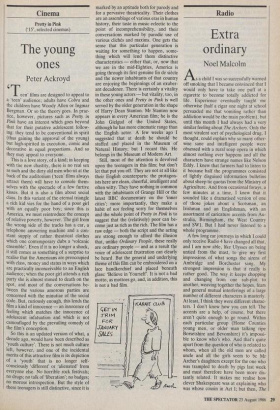Cinema
Pretty in Pink (`15', selected cinemas)
The young ones
Peter Ackroyd
Teen' films are designed to appeal to a 'teen' audience; adults have Cobra and the children have Woody Allen or Ingmar Bergman. Or so the theory goes. In prac- tice, however, pictures such as Pretty in Pink have an interest which goes beyond that for their putative adolescent follow- ing: they tend to be conventional in spirit (thus gaining the approval of the young) but high-spirited in execution, comic and decorative in equal proportions. And so they may appeal to everyone.
This is a love story, of a kind; in keeping with the new chastity, there is no real sex as such and the dirty old men who sit at the back of the auditorium (`teen' films always attract them) will have to console them- selves with the spectacle of a few furtive kisses. But it is also a film about social class. In this variant of the eternal triangle a rich kid vies for the hand of a poor girl with an equally poor boy; since this is America, we must reintroduce the concept of relative poverty, however. The girl from the wrong side of the tracks has a car, a telephone answering machine and a con- stant supply of rather theatrical clothes which one contemporary dubs a 'volcanic ensemble'. Even if it is no longer a shock, it still comes as something of a surprise to realise that the Americans are preoccupied with class, money and status in ways which are practically inconceivable to an English audience; when the poor girl attends a rich party she is almost stoned to death on the spot, and most of the conversations be- tween the various amorous parties are concerned with the minutiae of the social code. But, curiously enough, this lends the film a kind of innocence — an innocence of feeling which matches the innocence of adolescent infatuation and which is not camouflaged by the prevailing comedy of the film's conception.
So this is an updated version of what, a decade ago, would have been described as `youth culture'. There is not much culture left, however, and one of the incidental merits of this attractive film is its depiction of a 'youth' that is no longer self- consciously 'different' or 'alienated' from everyone else. No horrible rock festivals; no drugs; no talk of liberation'; no badges; no morose introspection. But the style of these teenagers is still distinctive, since it is marked by an aptitude both for parody and for a pervasive theatricality. Their clothes are an assemblage of various eras in human history, their taste in music eclectic to the point of incomprehensibility, and their conversations marked by parodic use of various clichés and maxims. One gets the sense that this particular generation is waiting for something to happen, some- thing which will lend them distinctive characteristics — either that, or, now that we are in the mid-Eighties, America is going through its first genuine fin de siècle and the newer inhabitants of that country are enjoying the beginnings of an exuber- ant decadence. There is certainly a vitality in these young actors — but vitality, too, in the other ones and Pretty in Pink is well served by the older generation in the shape of Harry Dean Stanton. Mr Stanton now appears in every American film; he is the John Gielgud of the United States, although he has more cinematic range than the English actor. A few weeks ago I suggested that at death he should be stuffed and placed in the Museum of Natural History; but I recant this. He belongs in the Museum of Modern Art. Still, most of the attention is devolved upon the teenagers in this film; but don't let that put you off. They are not at all like their English counterparts: the protagon- ists here are clean, cheerful, intelligent and often witty. They have nothing in common with the inhabitants of Grange Hill or the latest BBC documentary on the 'inner cities'; more importantly, they make a habit of not feeling sorry for themselves and the whole point of Pretty in Pink is to suggest that the (relatively) poor can be- come just as rich as the rich. The film has a raw edge — both the script and the acting are strong enough to afford the illusion that, unlike Ordinary People, these really are ordinary people — and as a result the voice of adolescent frustration can clearly be heard. But the general and underlying theme of this film can be embroidered on a lace handkerchief and placed beneath glass: 'Believe in Yourself. It is not a bad motto, as mottoes go, and, in addition, this is not a bad film.










































 Previous page
Previous page